-
History & Society
- Education in Pre-war Hong Kong
- History of Taikoo Sugar Refinery
- Hong Kong Products Exhibition
- Local Festivals Around the Year
- Post-war Industries
- Pre-war Industry
- The Hong Kong Jockey Club Archives
- Tin Hau Festival
- Memories We Share: Hong Kong in the 1960s and 1970s
- History in Miniature: The 150th Anniversary of Stamp Issuance in Hong Kong
- A Partnership with the People: KAAA and Post-war Agricultural Hong Kong
- The Oral Legacies (I) - Intangible Cultural Heritage of Hong Kong
- Hong Kong Currency
- Hong Kong, Benevolent City: Tung Wah and the Growth of Chinese Communities
- The Oral Legacies Series II: the Representative List of the Intangible Cultural Heritage of Hong Kong
- Braving the Storm: Hong Kong under Japanese Occupation
- A Century of Fashion: Hong Kong Cheongsam Story
Geography & EnvironmentArt & Culture- Calendar Posters of Kwan Wai-nung
- Festival of Hong Kong
- Ho Sau: Poetic Photography of Daily Life
- Hong Kong Cemetery
- Sketches by Kong Kai-ming
- The Culture of Bamboo Scaffolding
- The Legend of Silk and Wood: A Hong Kong Qin Story
- Journeys of Leung Ping Kwan
- From Soya Bean Milk To Pu'er Tea
- Applauding Hong Kong Pop Legend: Roman Tam
- 他 FASHION 傳奇 EDDIE LAU 她 IMAGE 百變 劉培基
- A Eulogy of Hong Kong Landscape in Painting: The Art of Huang Bore
- Imprint of the Heart: Artistic Journey of Huang Xinbo
- Porcelain and Painting
- A Voice for the Ages, a Master of his Art – A Tribute to Lam Kar Sing
- Memories of Renowned Lyricist: Richard Lam Chun Keung's Manuscripts
- Seal Carving in Lingnan
- Literary Giant - Jin Yong and Louis Cha
Communication & Media- Hong Kong Historical Postcards
- Shaw Brothers’ Movies
- Transcending Space and Time – Early Cinematic Experience of Hong Kong
- Remembrance of the Avant-Garde: Archival Camera Collection
- Down Memory Lane: Movie Theatres of the Olden Days
- 90 Years of Public Service Broadcasting in Hong Kong
- Multifarious Arrays of Weaponry in Hong Kong Cinema
-
History & SocietyGeography & EnvironmentArt & Culture
-
View Oral History RecordsFeatured StoriesAbout Hong Kong Voices
-
Hong Kong Memory
- Collection
- All Items
- Entertainment
Recently VisitedEntertainment
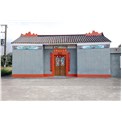
- Chou Wong Yi Kung Study Hall
Chou Wong Yi Kung Study Hall was built in 1684 to honour Chou Yau Tak, Viceroy of Guangdong and Guangxi, and Wong Loi Yam, Governor of Guangdong, whose pleading with the Emperor ended the forced coastal evacuation and allowed the clan to return to Kam Tin. The study hall houses the soul tablets of the two officials and a number of stone tablets recording the history of the coastal evacuation and the study hall, making them valuable artefacts.
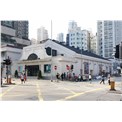
- Yau Ma Tei Theatre
Built in 1930, Yau Ma Tei Theatre is a blend of Chinese and Western architectural styles. The two pillars at the front entrance are engraved with crying and laughing masks. The theatre features a Chinese tiled roof, an Art Deco facade and gable walls. Yau Ma Tei Theatre is the oldest surviving theatre in the urban district, and has been revitalised as a performing arts centre for promoting Cantonese opera.
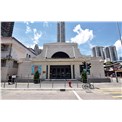
- Facade and gable walls of Yau Ma Tei Theatre
Yau Ma Tei Theatre with a Chinese tiled roof and Art Deco facade and gable walls.
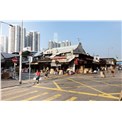
- Yau Ma Tei Fruit Market
Yau Ma Tei Fruit Market, founded in 1913, was originally a wholesale market for vegetables and fish. From 1965 onwards, it has been used solely by fruit wholesalers. The rectangular market consists of several blocks of one to two storeys high brick-and-stone buildings. The gables and pediments of some of the buildings are in Dutch Colonial style, while some facades are engraved with shop names, which are the architectural highlights of the Fruit Market.
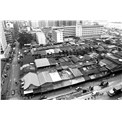
- Bird's-eye view of Yau Ma Tei Fruit Market
Bird's-eye view of Yau Ma Tei Fruit Market in 1995.
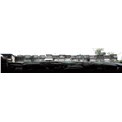
- Facades of Yau Ma Tei Fruit Market
Facades engraved with shop names, Yau Ma Tei Fruit Market.
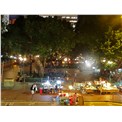
- Yung Shue Tau
This is a square located in front of Tin Hau Temple in Yau Ma Tei. It is well known as Yung Shue Tau (Banyan Tree Stump) because of the big banyan trees there. In the old days, entertainers gathered in this market commonly known as Poor Man's Nightclub, offering fortune-telling, Cantonese opera singing and storytelling, which attracted large numbers of spectators.
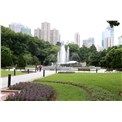
- Hong Kong Zoological and Botanical Gardens (Bing Tau Fa Yuen)
The Hong Kong Zoological and Botanical Gardens were opened to the public in 1864, making it the oldest public garden in Hong Kong. It was first named the Botanical Garden because it was intended to be for research on plants in Hong Kong. Later animals were introduced, and in 1975 it was renamed the Hong Kong Zoological and Botanical Gardens. The site of the Botanical Garden once served as temporary Government House, and subsequently, the official Government House was built on northern side of the garden. Since the Governor commanded the armed forces, he was called Bing Tau (chief commander) and the garden was called Bing Tau Fa Yuen (chief commander's garden).
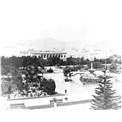
- The Botanical Garden in the past
The Botanical Garden with the then Government House (Governor's residence) in the background, circa 1865 to 1870.
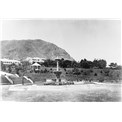
- Fountain in the Botanical Garden
Fountain in the Botanical Garden in 1869, with a cast-iron bandstand in the background. Martial music performance took place in the bandstand in the old days.
Copyright © 2012 Hong Kong Memory. All rights reserved.
| Set Name |





